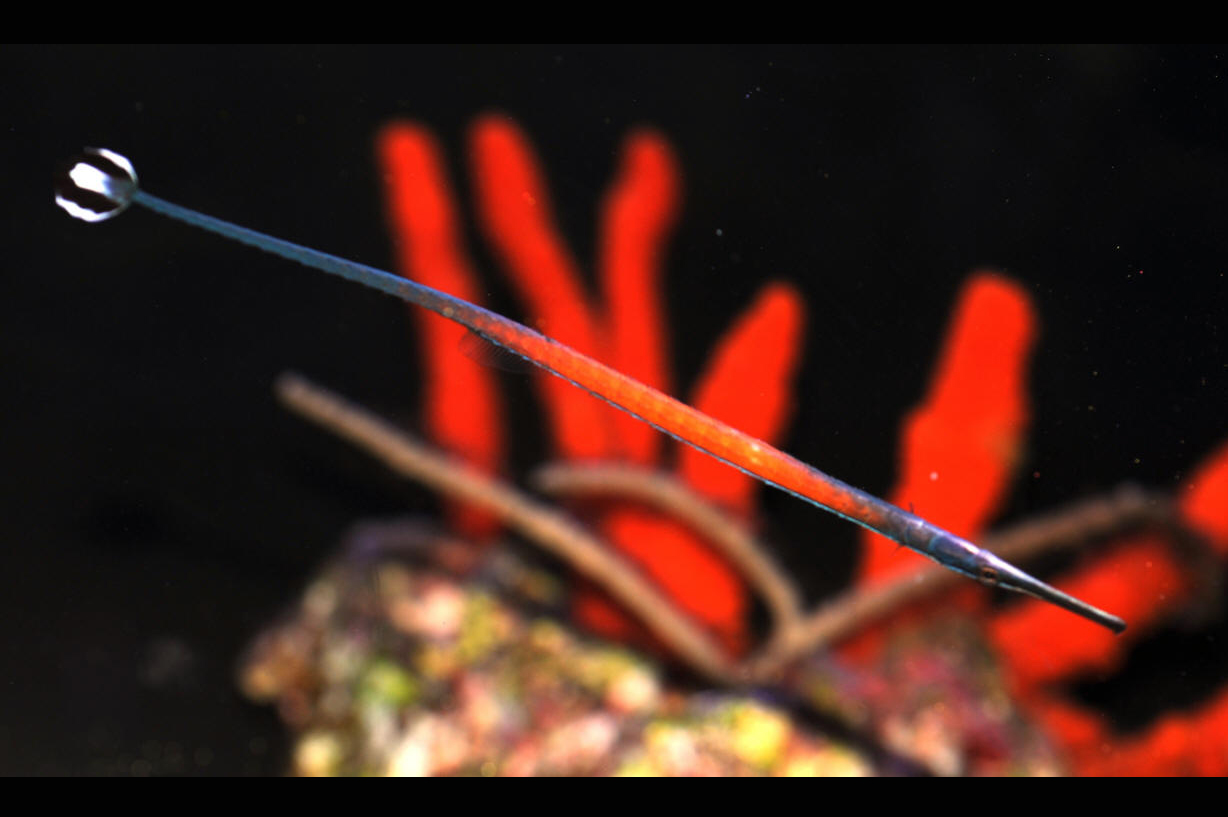Cleaner Pipefish, Doryrhamphus janssi (Herald & Randall 1972)

A Cleaner Pipefish, Doryrhamphus janssi, in an aquarium. Source: www.wetwebmedia.com. License: All rights reserved
A striking pipefish with the middle section of the body orange, the head and tail sections blue, and the fan-like caudal fin black with a white margin and a white central spot. Cleaner Pipefish are often seen swimming upside-down, and actively maintain cleaning stations at crevice and cave entrances, working in pairs to pick parasites from other fishes.
Cleaner Pipefish, Doryrhamphus janssi (Herald & Randall 1972)
More Info
|
Distribution |
Tropical East Indo-west Pacific from the Andaman Sea and Gulf of Thailand, to the Solomon Islands, Micronesia, the Philippines and northern Australia. Inhabits sheltered inshore coral reefs where pairs usually maintain cleaning stations in caves and crevices with sponges, and below large plate corals. |
|
Features |
Dorsal fin 22-25; Pectoral fin 19-21; Trunk rings 16; Tail rings 21-23. Head length 4.2-5.2 in SL; snout longer and more slender than congeners, length 1.5-1.8 in HL, snout depth 7.6-12.6 in snout length; males without bony ventrolateral projections on snout. Superior trunk and tail ridges discontinuous; inferior trunk ridge ending on anal ring; principle ridges of posterior predorsal rings with two spines on each ring, those of tail rings with one spine. Caudal fin fan-like. |
|
Size |
To 13-14 cm TL |
|
Colour |
Middle section of body orange, head and tail sections blue, caudal fin largely black, with a white margin and with a white central spot. |
|
Feeding |
Pairs actively maintain cleaning stations where they remove parasites from other fishes, especially from cardinalfishes of the genus Cheilodipterus and damselfishes of the genus Neopomacentrus. |
|
Biology |
Males brood the eggs in a semi-exposed pouch under the trunk; males begin brooding at 80 mm TL. |
|
Fisheries |
Collected incidentally for the international aquarium industry. |
|
Conservation |
|
|
Remarks |
Occur singly or in pairs; usually seen swimming upside-down. |
|
Similar Species |
This species can be distinguished from other members of the genus Doryramphus by the higher number of tail rings (21-23 versus 11-17). |
|
Etymology |
Doryrhamphus is from the Greek, dory meaning lance and the Greek, rhamphos for bill, beak. The specific is named after Mr. Edwin Janss Jr. |
|
Species Citation |
Dentirostrum janssi Herald & Randall 1972, Proc. Calif. Acad. Sci. 39(11): 124, fig. 1. Type locality: Koror Island, Palau Islands, 7°19'28"N, 134°30'12"E, depth 0-15.2 m. |
|
Author |
Thompson, Vanessa J. & Dianne J. Bray |
Cleaner Pipefish, Doryrhamphus janssi (Herald & Randall 1972)
References
Allen, G.R. 1997. Marine fishes of tropical Australia and south-east Asia. Western Australian Museum, Perth. 292 pp.
Allen, G.R. & M. Adrim. 2003. Coral reef fishes of Indonesia. Zool. Stud. 42(1): 1-72.
Allen, G.R. & Erdmann, M.V. 2012. Reef fishes of the East Indies. Perth : Tropical Reef Research 3 vols, 1260 pp.
Allen, G.R. & R. Swainston. 1988. The marine fishes of north-western Australia. A field guide for anglers and divers. Western Australian Museum, Perth. 201 pp.
Dawson, C.E. 1981. Review of the Indo-Pacific pipefish genus Doryrhamphus Kaup (Pisces: Syngnathidae), with descriptions of a new species and a new subspecies. Ichthyol. Bull. J.L.B. Smith Inst. 44: 1-27, figs. 1-17.
Dawson, C.E. 1985. Indo-Pacific Pipefishes (Red Sea to the Americas). Gulf Coast Research Laboratory, Ocean Springs, Mississippi. 230 pp.
Fritzsche, R., Matsuura, K., Collette, B., Nelson, J., Dooley, J., Carpenter, K., Bartnik, S., Robinson, E., Sorensen, M. & Morgan, S.K. 2010. Doryrhamphus janssi. In: IUCN 2013. IUCN Red List of Threatened Species. Version 2013.1. <www.iucnredlist.org>. Downloaded on 10 June 2012.
Herald, E.S. & J.E. Randall. 1972. Five new Indo-Pacific pipefishes. Proc. Calif. Acad. Sci. 39(11): 121-140.
Hoese, D.F., D.J. Bray, J.R. Paxton & G.R. Allen. 2006. Fishes. In Beesley, P.L. & A. Wells (eds). Zoological catalogue of Australia. Volume 35. ABRS & CSIRO Publishing: Australia. 2178 pp.
Kuiter, R.H. 1992. Tropical reef-fishes of the western Pacific Indonesia and adjacent waters. Gramedia Pustaka Utama, Jakarta. 314 pp.
Kuiter, R.H. 1997. Guide to sea fishes of Australia. A comprehensive reference for divers and fishermen. New Holland Publishers, Frenchs Forest, NSW, Australia. 434 pp.
Kuiter, R.H. 2000. Seahorses, Pipefishes and their Relatives. TMC Publishing, Chorleywood, UK. 240 pp.
Kuiter, R.H. & T. Tonozuka. 2001. Pictorial guide to Indonesian reef fishes. Part 1. Eels- Snappers, Muraenidae - Lutjanidae. Zoonetics, Australia. 302 pp.
Michael, S.W. 1998. Reef Fishes Volume 1. A Guide to Their Identification, Behaviour and Captive Care. Microcosm Ltd. Shellbourne, Vermont. 624 pp.
Myers, R.F. 1999. Micronesian reef fishes. A comprehensive guide to the coral reef fishes of Micronesia. 3rd revised ed. Coral Graphics, Guam. 330 pp, 192 pls.
Paulus, T. 1999. Family Syngnathidae. pp 2264-2276, In Carpenter K.E. & Niem V.H. (eds) The Living Marine Resources of the Western Central Pacific. FAO Species Identification Guide For Fisheries Purposes. FAO Vol. 4. pp 2069-2790.
Pogonoski, J.J., D.A. Pollard & J.R. Paxton. 2002. Conservation Overview and Action Plan for Australian Threatened and Potentially Threatened Marine and Estuarine Fishes, Environment Australia, Canberra. 375 pp.
Randall, J.E., Allen, G.R. & R.C. Steene. 1997. Fishes of the Great Barrier Reef and Coral Sea. Crawford House Press. Bathurst. 557 pp.




